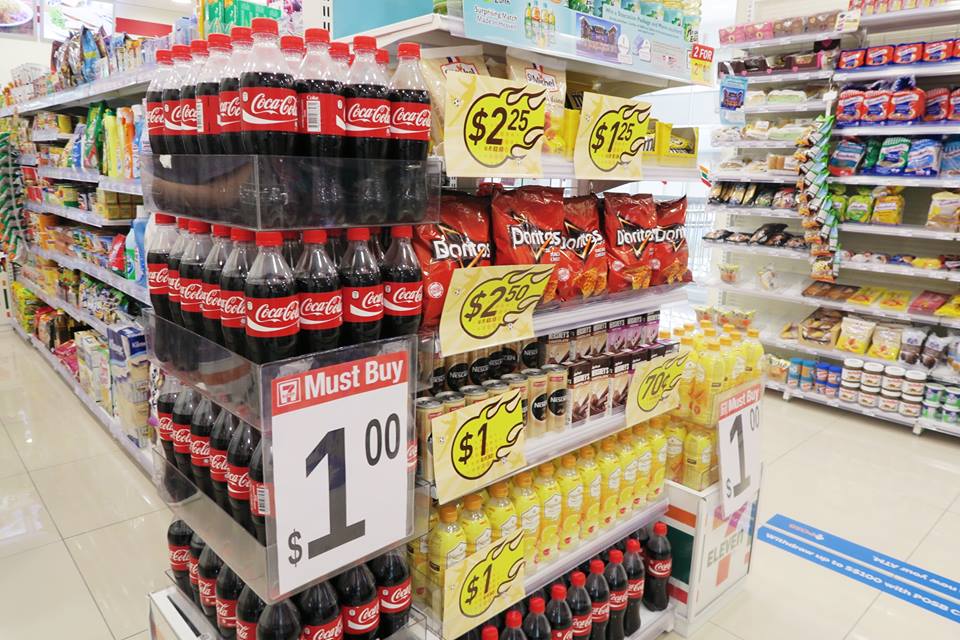This article was first published on DollarsAndSense.sg
7-Eleven is the epitome of a convenience store, where we would head in to grab something on the way to our next destination. Upon paying for our purchases, we noticed that their products are priced higher than local supermarkets.
If you feel the pinch to your pocket, you are not alone. Many who patronize 7-Eleven would feel ripped off regret their decision, and wished that they had spared the effort to go to a supermarket instead.
You may wonder, “They are just a small convenience store, why are things there so expensive?” Here are 4 reasons why:
Marketing cost

Everyone knows what 7-Eleven is. Their radio ads, newspaper ads, and flyers cost money. The aggressive marketing strategy 7-Eleven adopts cost them a lot. Brand recognition makes 7-Eleven what it is today; they stand out from other convenience stores, including Cheers.
By frequently promoting snacks, including their Slurpees, Big Gulp, and cup noodles, 7-Eleven positions themselves as a convenient place to grab a bite.
Apart from snacks, some stores have a Singapore Pools outlet that attracts customers that are likely to buy something on their way out. We discuss the implications behind their convenience later.
Maintenance of machines

7-Eleven stores have many snacks available that you’d be spoilt for choices on a late night binge. They have their Slurpee, mash Potato, soft ice, steamed buns, cup noodles, and even ready-to-eat meals like butter chicken and sandwiches. To ensure that their Slurpee machine, and other machines work 24/7, maintenance has to be carried out.
7-Eleven has to employ technicians who require salary to upkeep their stores. Since they have so many stores in Singapore, maintenance would contribute to their overhead costs, reducing 7-Eleven’s profit margin.
Low economies of scale is not enough

7-Eleven is part of their parent company Dairy Farm International, which owns Cold Storage and Giant. They may enjoy more economies of scale than their competitors.
A firm as large as Dairy Farm has more bargaining power with suppliers than the heartland convenience store below your block. Through Dairy Farm, 7-Eleven may get to purchase their stocks at a lower price than rivals like Econ Minimart, Cheers, and independently-owned convenience stores.
These cost savings translate to a higher profit margin when we don’t consider other cost drivers. This means that 7-Eleven can afford to charge customers lower if they choose to.
Nonetheless, other cost drivers such as rent and maintenance costs are very important things to consider too.
As they have many outlets, 7-Eleven has a higher marginal cost compared to supermarkets. This means that they need to increase revenue per sales by charging a higher price, to be profitable. Otherwise, it is almost impossible to sustain its current network of stores.
Given a small store space, 7-Eleven’s turnover rate will never be as high as a supermarket. In supermarkets like NTUC and Cold Storage, thousands of people patronize them daily, and buy several items of groceries.
When each customer buys fewer things, less money is spent. 7-Eleven will not have high volumes of cash flow per transaction if they adopt the same pricing strategy as NTUC.
Read also: 24/7 hymns of groundbreaking delicacies at 7Eleven
Premium for convenience

After all, they did say, “It’s a store and more.” What you are paying for is the “more”.
Miscellaneous services include an AXS machine to pay bills, cash withdrawal, and Cashcard top up. These are the urgent errands you might need to do when other shops are not open. Yes, you have no choices at times like that. Actually, it is when the price is inelastic in demand (meaning that you have no choice but to patronize them at certain odd hours) that validates the premium price you pay when you buy anything. For 7-Eleven to make these services available, they do have to pay the companies a (probably significant) fee.
There are common things we buy at 7-Eleven. Sanitary pads, Panadol, magazines, or bread. It is easy, fast, and convenient. There are no long grocery lines because people don’t buy so many things.
Rental

7-Eleven pays higher rent for their stores because they rent a smaller space. Think of it like buying a house. The bigger the house, the lower price per square foot. The reverse is the same, as we see in the case of a 7-Eleven store.
It is difficult for landlords to estimate the monthly sales revenue of a store they lease out. But a 7-Eleven outlet would be a different case. As they would expect to see high volumes of sales (i.e. more customers), the landlord would expect higher revenue and raise rentals. Thus, when 7-Eleven has to cover cost, it has to come from their product sales. 7-Eleven standardize their prices across all their stores. This means all stores require a higher price to survive even if a particularly profitable store can offset the loss sustained in another heartland outlet.
24/7 staff

There are approximately 560 7-Eleven stores island-wide. All their stores require overnight staff, unlike supermarkets, where majority of their outlets are not open 24/7. This means that 7-Eleven has to hire a few hundred staff to cover the night shift, which wages, logically, should be higher than day shift staff. This contributes to cost for the company, more so when there are rarely any customers making purchases in the wee hours of the night.
DollarsAndSense.sg is a website that aims to help people make better financial decisions. If you like what you read, subscribe to the Dollars And Sense Newsletter.





Reader Interactions